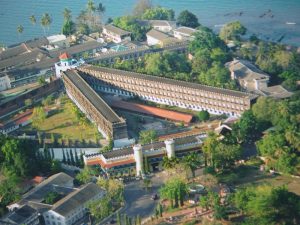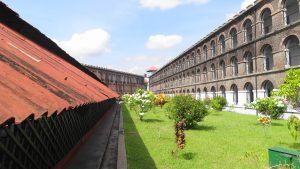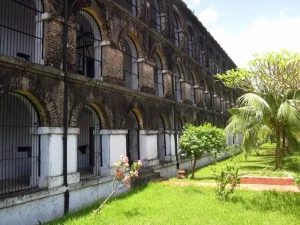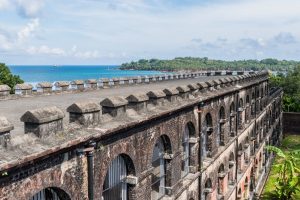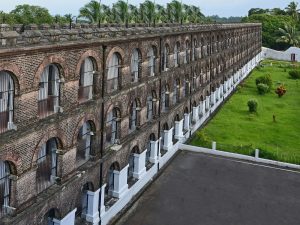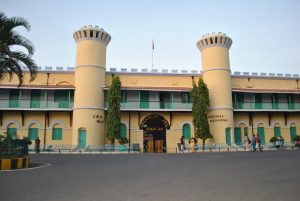The Cellular Jail, also known as Kālā Pānī (derived from Sanskrit words ‘Kal’ which means Time or Death and ‘Pani’ which means Water), was a colonial prison in the Andaman and Nicobar Islands, India. The prison was used by the British especially to exile political prisoners to the remote archipelago. Many notable dissidents such as Batukeshwar Dutt and Veer Savarkar, among others, were imprisoned here during the struggle for India’s independence. Today, the complex serves as a national memorial monument. Although the prison complex itself was constructed between 1896 and 1906, the British had been using the Andaman islands as a prison since the days in the immediate aftermath of the Sepoy Mutiny of 1857. Shortly after the rebellion was suppressed, the British executed many rebels. Those who survived were exiled for life to the Andamans to prevent their re-offending. Two hundred rebels were transported to the islands under the custody of the jailer David Barry and Major James Pattison Walker, a military doctor who had been warden of the prison at Agra. Another 733 from Karachi arrived in April, 1868. In 1863, the Rev. Henry Fisher Corbyn, of the Bengal Ecclesiastical Establishment, was also sent out there and he set up the ‘Andamanese Home’ there, which was also a repressive institution albeit disguised as a charitable one. Rev. Corbyn was posted in 1866 as Vicar to St. Luke’s Church, Abbottabad, and later died there and is buried at the Old Christian Cemetery, Abbottabad. More prisoners arrived from India and Burma as the settlement grew. Anyone who belonged to the Mughal royal family, or who had sent a petition to Bahadur Shah Zafar during the Rebellion was liable to be deported to the islands. The remote islands were considered to be a suitable place to punish the independence activists. Not only were they isolated from the mainland, the overseas journey (Kala Pani) to the islands also threatened them with loss of caste, resulting in social exclusion. The convicts could also be used in chain gangs to construct prisons, buildings and harbour facilities. Many died in this enterprise. They served to colonise the island for the British. By the late 19th century the independence movement had picked up momentum. As a result, the number of prisoners being sent to the Andamans grew and the need for a high-security prison was felt. From August 1889 Charles James Lyall served as home secretary in the Raj government, and was also tasked with an investigation of the penal settlement at Port Blair. He and A. S. Lethbridge, a surgeon in the British administration, concluded that the punishment of transportation to the Andaman Islands was failing to achieve the purpose intended and that indeed criminals preferred to go there rather than be incarcerated in Indian jails. Lyall and Lethbridge recommended that a “penal stage” should exist in the transportation sentence, whereby transported prisoners were subjected to a period of harsh treatment upon arrival. The outcome was the construction of the Cellular Jail, which has been described as “a place of exclusion and isolation within a more broadly constituted remote penal space.” The construction of the prison started in 1896 and was completed in 1906. The original building was a puce-colored brick building.The bricks used to build the building were brought from Burma. The building had seven wings, at the centre of which a tower served as the intersection and was used by guards to keep watch on the inmates; this format was based on Jeremy Bentham’s idea of the Panopticon. The wings radiated from the tower in straight lines, much like the spokes of a bicycle wheel. A large bell was kept in the tower to raise an alarm. Each of the seven wings had three stories upon completion. There were no dormitories and a total of 693 cells. Each cell was 4.5 by 2.7 metres (14.8 ft × 8.9 ft) in size with a ventilator located at a height of 3 metres (9.8 ft). The name, “cellular jail”, derived from the solitary cells which prevented any prisoner from communicating with any other. Also, the spokes were so designed such that the face of a cell in a spoke saw the back of cells in another spoke. This way, communication between prisoners was impossible. They were all in solitary confinement. Solitary confinement was implemented as the British government desired to ensure that political prisoners and revolutionaries be isolated from each other. The Andaman island served as the ideal setting for the government to achieve this. Most prisoners of the Cellular Jail were independence activists. Some famous inmates of the Cellular Jail were Diwan Singh Kalepani, Fazl-e-Haq Khairabadi, Yogendra Shukla, Batukeshwar Dutt, Maulana Ahmadullah, Movli Abdul Rahim Sadiqpuri, Maulvi Liaquat Ali, Babarao Savarkar, Vinayak Damodar Savarkar, Bhai Parmanand, Shadan Chandra Chatterjee, Sohan Singh, Vaman Rao Joshi and Nand Gopal. Several revolutionaries tried in the Alipore Case (1908) such as Barindra Kumar Ghose, Upendra Nath Banerjee, Birendra Chandra Sen. Jatish Chandra Pal, the surviving companion of Bagha Jatin, was transferred to Berhampore Jail in Bengal, before his mysterious death in 1924. Savarkar brothers Babarao and Vinayak didn’t know of each other in the same jail but in different cells, for two years. In March 1868, 238 prisoners tried to escape. By April they were all caught. One committed suicide and of the remainder Superintendent Walker ordered 87 to be hanged. Hunger strikes by the inmates during the early 1930s called attention to their imprisonment. Mahavir Singh, an associate of Bhagat Singh (Lahore conspiracy case) protested the inhuman treatment meted to the prisoners and sat in hunger strike. He was force fed milk which went into his lungs and he died. He was tied to a stone and thrown in the sea. Mahatma Gandhi and Rabindranath Tagore intervened. The government decided to repatriate the political prisoners from the Cellular Jail in 1937-38. Another two wings of the jail were demolished after India achieved independence. However, this led to protests from several former prisoners and political leaders who saw it as a way of erasing the tangible evidence of their persecution. The remaining three wings and the central tower were therefore converted into a National Memorial in 1969. The Govind Ballabh Pant Hospital was set up in the premises of the Cellular Jail in 1963. It is now a 500-bed hospital with about 40 doctors serving the local population. The centenary of the jail’s completion was marked on 10 March 2006. Many erstwhile prisoners were felicitated on this occasion by the Government of India.
Gallery
